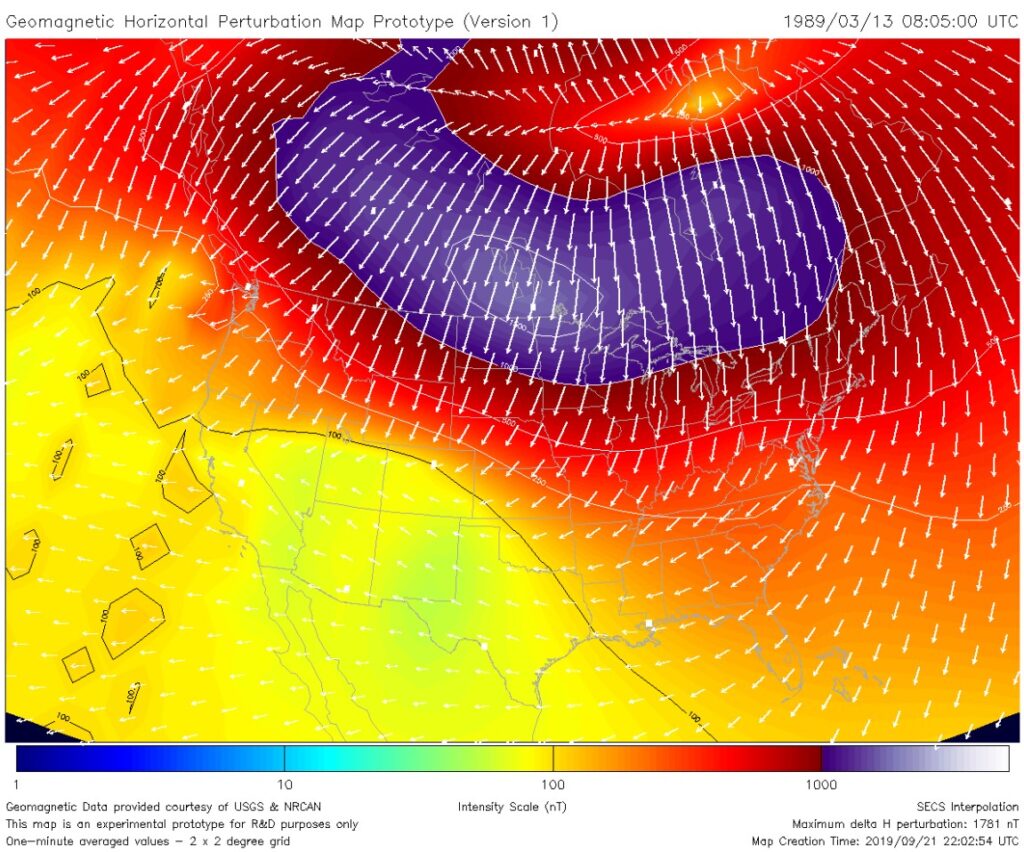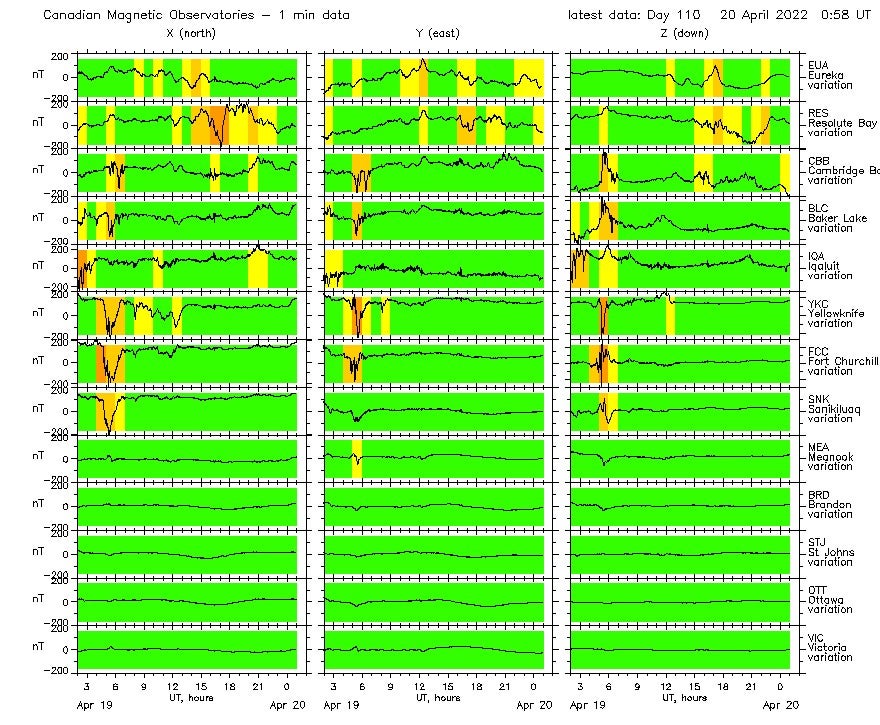
You have probably already heard a little about the most ridiculous threat to modern power systems. Solar activity can wipe out unprepared grids from millions of miles away. But despite this ancient and ever-present threat, most look toward one particular incident as proof.
Early on the morning of 13 March 1989, the Canadian province of Quebec lost all power for nine hours. Later, power company Hydro Quebec stated that a solar flare had overloaded five power lines simultaneously, taking 9.45GW of consumption off the grid instantly. Losing demand equivalent to a medium-sized city unbalanced the rest of the grid, causing it to shut down entirely within one minute.
Some cite the incident, alongside the words “solar flare” and “electromagnetic pulse”, to describe the unknowable threat from above. But in truth, generators, transmission grids, and governments are better prepared for a “black sky event”.
The misconceptions around black sky events
Strictly speaking, a “black sky event” is any occurrence that severely disrupts critical infrastructure of any kind. Its sibling, the “black swan event”, was used to describe the severity and irregularity of the Covid-19 pandemic. For the power industry, electromagnetic disruption is the most likely cause of a black sky event.
The most widespread threat for these events comes in Canada and the US. However, a solar flare did not cause the power outage in Quebec. While solar flares give an easily-understood term to the sun’s activity, the real threat comes from coronal mass ejections.
When solar activity creates a massive clump of super-hot and magnetically-charged plasma, it often falls back down into the sun as a solar flare. If this mass breaks free and scatters into space, it becomes a coronal mass ejection (CME). If this CME happens to cross paths with Earth, only then can problems arise.
How well do you really know your competitors?
Access the most comprehensive Company Profiles on the market, powered by GlobalData. Save hours of research. Gain competitive edge.

Thank you!
Your download email will arrive shortly
Not ready to buy yet? Download a free sample
We are confident about the unique quality of our Company Profiles. However, we want you to make the most beneficial decision for your business, so we offer a free sample that you can download by submitting the below form
By GlobalDataThe unusual and dramatic nature of these events has attracted interest and fictionalisation from storytellers. Films have depicted disasters caused by solar flares and CMEs, mostly with significant exaggeration. Online, doomsday preparation fanatics swap advice on how to shield electronics from electromagnetic interference. Similarly, some conspiracy theorists insist on linking solar activity with health conditions, despite the lack of evidence and contradictions within their own logic.
The reality is simpler. On its website, NASA emphasises that solar weather cannot destroy Earth, as portrayed in some films. It states that solar activity “is a problem the same way hurricanes are a problem. One can protect oneself with advance information and proper precautions”.
The value of forecasting solar weather
Weather, on Earth and in space, damages power transmission systems. But just as meteorologists can forecast Earth’s weather, astronomers forecast solar weather. This gives notice of potential Earth-bound hazards in advance, giving infrastructure operators time to prepare. For CMEs, observations can give between 14 and 96 hours warning of potential disruption.
In Canada, monitoring the sun’s activity falls to the Space Weather Forecasting Centre (SWFC). In the US, this falls under the purview of the National Oceanic and Atmospheric Administration (NOAA). These organisations also monitor the solar winds that cause aurora over the North and South Poles, where Earth’s natural magnetism gives the least protection.
Separately, most US citizens will live within 35km of a magnetometer. The MTArray project has blanketed the northern contiguous US with these devices, made to measure magnetic fields. These give a “heatmap” of electromagnetism in the US, showing natural variations and the shifts caused by CMEs. Most of the time, this makes one thing clear: solar storms are Canada’s problem.

The NOAA rates radio disruption and solar storms on a five-tier system, measuring the practical impact of space weather. This rating also has implications for satellite services, such as GPS or specialist communications. Disruption comes rarely, but follows a predictable long-term cycle.
Just like the Earth, the sun has seasons. The next upcoming “solar maximum”, the period of greatest solar activity, will begin in 2024. This does not guarantee disruption from solar activity or even make it likely, but it does represent the maximum risk to earth for approximately 11 years.
How summer on the sun will cause difficulty for grids
The slow build up to this point also sees an increase in solar activity. In March 2022, Earth witnessed three coronal mass ejections in unusually rapid succession. These mostly missed our planet, but near the end of the month the NOAA warned of a “moderate” geomagnetic storm.
This would briefly push transmission grid voltages toward alarm zones near the planet’s poles, where solar weather is most keenly felt. However, after warning of this storm, another solar eruption caused the agency to upgrade its warning to “strong”.
The new CME travelled faster than the first, impacting Earth at the end of March. Geomagnetic storms rated as “strong” have the power to increase the voltage of power lines, requiring grid operators to adjust their transmission systems to keep them within safe limits. These adjustments are delicate, but not entirely uncommon.
Strong geomagnetic events take place on approximately 130 days of an 11-year solar cycle. By comparison, the most damaging events happen on approximately four days in the same period. These are the events that can cause transformers to damage themselves with unpredictable voltage spikes.

In most cases, dealing with solar weather and CMEs starts with closely monitoring voltages across electricity networks. Advances in sensor technology have made this easier than ever, enabling reports from remote areas via satellite. Automated maintenance systems are also more intelligent than ever, raising voltage alarms whenever necessary. Then, engineers manage generation and power flow to keep voltage within a safe range.
A CME makes this more difficult, like keeping a car with loose wheels safely on the road. Momentary spikes in voltage can overload systems or cause physical damage to systems, so power companies know the procedures for dealing with these events.
How to prepare your power grid for a solar storm
The NOAA and SWFC’s reports allow grid operators to prepare for storms, but the preparation procedures fall to another body. Terry Boston, former board member of the North American Electric Reliability Corp (NERC), once described the work done by the group: “What we do is not rocket science…it is more important than that.”
The NERC, a multinational not-for-profit organisation, prevents blackouts in Canada, the US, and a small part of Mexico. The body manages risks and sets standards for all six north American grids in all eventualities, including supply chain failures, electromagnetic weapons attacks, and black sky events.
To do this, the NERC requires all transmission systems operators and power generators to operate magnetometers. Grid operators must report any magnetic disturbances equal to the “strong” disruptions seen in March to NERC. Since May 2013, only 14 events have met this threshold, although this will not include recent events. As the solar cycle moves towards its peak, this list will grow more rapidly, before slowing with the cycle.
The NERC prides itself on being the only essential infrastructure regulator with enforcement powers. At the same time, legislation around solar storm preparation is minimal. Following its damaging winter storms, the state government of Texas passed a bill to better assess all threats to its power grid, including those from space. This passed in May 2021, inspiring a push for similar efforts in Utah.
The infrequent occurrence of infrastructure-threatening solar events rarely pushes them up lawmakers’ agendas. Part of this comes from power companies’ ability to handle voltage irregularities without severely disrupting power distribution.
While renewables have made the regular operations of power networks more complex, the increasing decentralisation of power generation and the rise of microgrids has made widespread blackouts like the Quebec incident less likely. At the same time, advancements in sensors technologies have made correcting for solar disruptions easier, while massive data collections have given power companies the tools to learn from any event.
A lot changes in 11 years, but advancements since 2014 might have solved the solar weather problem before it comes again.



